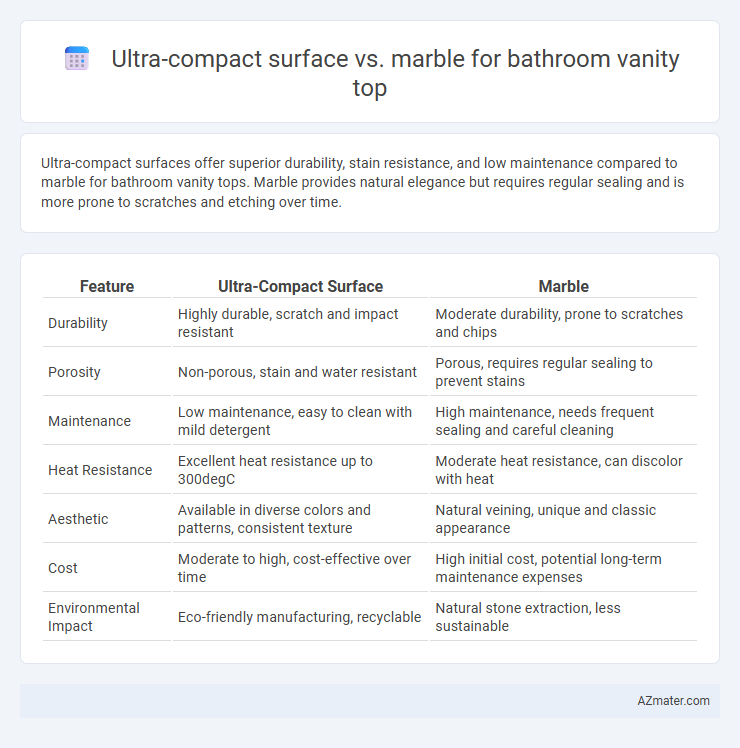Ultra-compact surfaces offer superior durability, stain resistance, and low maintenance compared to marble for bathroom vanity tops. Marble provides natural elegance but requires regular sealing and is more prone to scratches and etching over time.
Table of Comparison
| Feature | Ultra-Compact Surface | Marble |
|---|---|---|
| Durability | Highly durable, scratch and impact resistant | Moderate durability, prone to scratches and chips |
| Porosity | Non-porous, stain and water resistant | Porous, requires regular sealing to prevent stains |
| Maintenance | Low maintenance, easy to clean with mild detergent | High maintenance, needs frequent sealing and careful cleaning |
| Heat Resistance | Excellent heat resistance up to 300degC | Moderate heat resistance, can discolor with heat |
| Aesthetic | Available in diverse colors and patterns, consistent texture | Natural veining, unique and classic appearance |
| Cost | Moderate to high, cost-effective over time | High initial cost, potential long-term maintenance expenses |
| Environmental Impact | Eco-friendly manufacturing, recyclable | Natural stone extraction, less sustainable |
Introduction to Ultra-Compact Surfaces vs Marble for Bathroom Vanity Tops
Ultra-compact surfaces, made from a blend of natural minerals and advanced resins, offer superior durability and stain resistance compared to traditional marble vanity tops. Marble, prized for its classic elegance and unique veining, requires regular sealing and maintenance to prevent damage from moisture and scratches. Ultra-compact materials deliver enhanced heat resistance and a nearly non-porous finish, making them an ideal choice for modern bathroom vanity applications where longevity and ease of care are priorities.
Material Composition and Manufacturing Process
Ultra-compact surfaces are engineered primarily from a blend of natural minerals, quartz, and high-performance resins, making them highly durable, non-porous, and resistant to stains and scratches. Marble, a natural stone composed mainly of calcite, is quarried and cut into slabs, requiring sealing to protect its porous surface from moisture and staining. The manufacturing process of ultra-compact surfaces involves high-pressure lamination and sintering at extreme temperatures, resulting in a dense, uniform material, whereas marble's extraction and finishing focus on preserving natural veining and texture but can be more prone to chipping and wear over time.
Aesthetic Appeal: Colors, Patterns, and Designs
Ultra-compact surfaces offer a wide range of vibrant colors, intricate patterns, and customizable designs, providing versatility and modern aesthetic appeal for bathroom vanity tops. Marble showcases timeless elegance with its unique natural veining and subtle color variations, creating a luxurious and classic look. While marble delivers organic beauty, ultra-compact materials excel in durability and design consistency, making them ideal for bold and contemporary bathroom aesthetics.
Durability and Resistance to Wear
Ultra-compact surfaces boast exceptional durability and superior resistance to wear compared to marble, making them ideal for high-traffic bathroom vanity tops. Engineered with dense, non-porous materials, ultra-compact surfaces resist scratches, stains, and heat far better than natural marble, which is susceptible to etching and chipping from everyday use. While marble offers timeless elegance, ultra-compact surfaces provide longer-lasting performance with minimal maintenance in bathroom environments.
Maintenance and Cleaning Requirements
Ultra-compact surfaces require minimal maintenance due to their non-porous nature, resisting stains, scratches, and bacteria buildup, making cleaning effortless with just mild soap and water. Marble requires regular sealing to prevent staining and etching from acidic substances, with special cleaners needed to maintain its polished finish. The durability of ultra-compact materials reduces the frequency of deep cleaning and repairs compared to the high-maintenance care routine demanded by marble.
Stain, Scratch, and Heat Resistance Comparison
Ultra-compact surfaces exhibit superior stain resistance compared to marble, as their non-porous structure prevents absorption of liquids and chemicals, minimizing discoloration. In terms of scratch resistance, ultra-compact materials outperform marble due to their harder composition, reducing visible wear and maintaining a pristine appearance over time. Heat resistance is notably higher in ultra-compact surfaces, allowing them to withstand direct contact with hot objects without damage, whereas marble can develop thermal cracks or discoloration when exposed to high temperatures.
Cost Analysis: Upfront and Long-Term Investment
Ultra-compact surfaces typically have a higher upfront cost compared to marble, reflecting their advanced manufacturing process and durability. However, their low maintenance requirements and superior resistance to stains, scratches, and heat can result in lower long-term expenses. Marble, while often less expensive initially, may incur increased costs over time due to its porous nature, requiring regular sealing and potential repairs from etching or staining.
Installation Process and Flexibility
Ultra-compact surfaces offer a significantly lighter material composition compared to marble, simplifying the installation process by reducing the need for heavy-duty support structures and specialized labor. Their flexibility allows for precise cutting and custom shaping, accommodating intricate bathroom vanity designs and unusual layouts more easily than marble, which is rigid and prone to cracking. The ease of installation and versatility of ultra-compact surfaces reduce overall time and cost, making them a preferred choice in modern bathroom renovations over traditional marble tops.
Environmental Impact and Sustainability
Ultra-compact surfaces boast high durability and low maintenance, significantly reducing the need for frequent replacements and minimizing waste, which enhances their sustainability profile. Marble extraction involves quarrying that results in considerable environmental disruption, increased carbon footprint, and non-renewable resource depletion. Manufacturing ultra-compact surfaces often incorporates recycled materials and eco-friendly processes, making them a more environmentally responsible choice for bathroom vanity tops.
Pros and Cons: Which Is Right for Your Bathroom Vanity Top?
Ultra-compact surfaces offer exceptional durability, resistance to heat, scratches, and stains, making them ideal for high-traffic bathroom vanities requiring minimal maintenance. Marble provides natural elegance and unique veining patterns that enhance aesthetic appeal but requires regular sealing and careful upkeep to prevent etching and staining. Choosing between ultra-compact material and marble depends on whether durability and low maintenance or classic beauty and natural variation are your top priorities for a bathroom vanity top.

Infographic: Ultra-compact surface vs Marble for Bathroom vanity top
 azmater.com
azmater.com